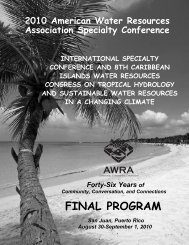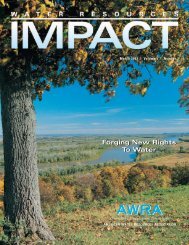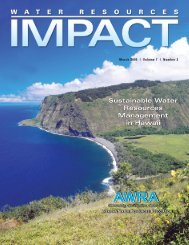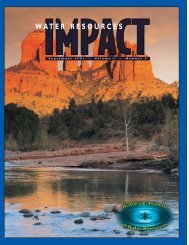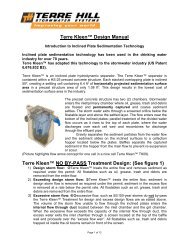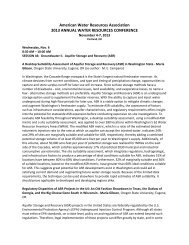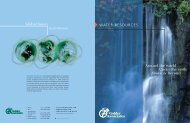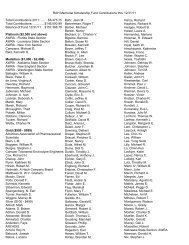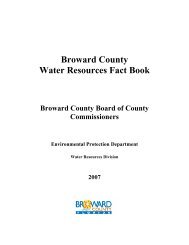N ovember 2 0 0 0 ⢠V olume 2 ⢠N umber 6 - American Water ...
N ovember 2 0 0 0 ⢠V olume 2 ⢠N umber 6 - American Water ...
N ovember 2 0 0 0 ⢠V olume 2 ⢠N umber 6 - American Water ...
You also want an ePaper? Increase the reach of your titles
YUMPU automatically turns print PDFs into web optimized ePapers that Google loves.
EPA PROGRAM TO CLEAN WATER MOVES PATHOGENS TO LAND:<br />
AGENCY FORCED TO REEVALUATE RULE<br />
Tom Randall<br />
The U.S. Environmental Protection Agency has asked<br />
the National Institutes of Health to examine the potential<br />
health threats posed by the application of Class B<br />
biosolids, or "sludge" made from municipal sewage, on<br />
farm fields.<br />
The request comes in response to the latest of two reports<br />
by the National Institute for Occupational Safety<br />
and Health (NIOSH) which identify Class B sludge as the<br />
source of pathogens which have caused severe, chronic<br />
illnesses in workers spreading sludge on fields. The report,<br />
NIOSH Publication No. 2000-158, dated August<br />
2000, observed that the illnesses could be prevented by<br />
processing all sludge to the pathogen-free Class A level.<br />
This report closely follows NIOSH’s report of last<br />
year, HETA 98-0118-278, dated August 1999, which<br />
found Class B sludge to be the likely cause of a rash of<br />
illnesses among sludge handlers in LeSourdsville, Ohio.<br />
It said the workers contracted gastro-intestinal diseases<br />
through either ingestion or inhalation of pathogens contained<br />
in the material. Both reports recommend stringent<br />
safety precautions, never mentioned in the EPA sludge<br />
regulation, 40 CFR Part 503, for workers handling Class<br />
B sludge – including the wearing of “protective clothing,<br />
boots, goggles and face shields.” They further say that<br />
such gear should be cleaned or discarded after use and<br />
workers immediately use on-site showers.<br />
NIOSH did not discuss the health threat Class B<br />
sludge poses to the general public since such<br />
matters do not fall under its charter. It did observe<br />
that 40 CFR Part 503, often simply referred<br />
to as the “sludge rule,” contains precautions<br />
for protecting the public but did not<br />
comment on the adequacy of those precautions<br />
or their enforcement. EPA Region 5 officials<br />
in Chicago, when contacted, said EPA<br />
has no enforcement policy for the application<br />
of Class B sludge and no enforcement personnel.<br />
EPA microbiologist, David L. Lewis, Ph.D.,<br />
who has been raising serious questions about EPA sludge<br />
policy since 1996 said, “The CDC (Centers for Disease<br />
Control and Prevention, of which NIOSH is a part) study<br />
shows what a serious oversight it was for EPA to approve<br />
Class B sludge without a comprehensive risk assessment<br />
for pathogens.”<br />
In addition to illnesses contracted by those working<br />
with Class B sludge in both Ohio and Pennsylvania, the<br />
material is also suspected by some experts to be responsible<br />
for the deaths of a young boy in Pennsylvania and a<br />
New Hampshire man several years ago.<br />
A spokesperson for Northfield, Illinois-based Kraft<br />
Foods, Inc. said the company refuses to accept food products<br />
grown on it.<br />
The Chicago<br />
Metropolitan area<br />
is an example of<br />
the extensive<br />
threat posed by<br />
Kern County, California, supervisors were so concerned<br />
about sludge being trucked into their county, they<br />
voted to phase out the dumping of all but “exceptionalquality”<br />
sludge which is one grade above Class A. Neither<br />
“exceptional quality” nor Class A sludge have been linked<br />
to pathogen hazards. “It frightens me . . . what we don’t<br />
know about biosolids and what scientists may learn tomorrow,”<br />
Supervisor Pete Parra told The Bakersfield Californian.<br />
CHICAGO AREA HIGHLIGHTS PROBLEM<br />
The Chicago Metropolitan area is an example of the<br />
extensive threat posed by sludge nationwide. A recent investigation<br />
by the Chicago Sun-Times found over 20,000<br />
tons of potentially disease-causing sludge made from<br />
human waste, including that from hospitals, is produced<br />
every year by the Metropolitan <strong>Water</strong> Reclamation District<br />
of Greater Chicago and spread over farm fields in<br />
several surrounding Illinois counties. The newspaper uncovered<br />
some 60 plus farm fields used for the disposal of<br />
sludge.<br />
In contrast to the CDC report and other expert opinions,<br />
U.S. EPA, Chicago's <strong>Water</strong> Reclamation District,<br />
and Wheelabrator Technologies Inc., whose BioGro division<br />
is a prime sludge contractor for the district, strenuously<br />
denied the material poses a threat to human health<br />
and uniformly dismissed the CDC report as irrelevant to<br />
their operations.<br />
Tom O'Connor, chief of maintenance and<br />
operations for the district, recognized as one<br />
of the largest and one of the best-run in the<br />
world, said he has confidence in the sludge<br />
rule but “would be open-minded” to any new<br />
data.<br />
John Colletti, from U.S. EPA Region 5, in<br />
Chicago, said the CDC report just showed<br />
workers should use common sense when<br />
handling sludge and that it would not cause<br />
EPA to look at changing its regulations.<br />
Wheelabrator public relations consultant, Bill Plunkett<br />
said, “The LeSourdsville study appears to be inconclusive<br />
and adds nothing to the body of knowledge about<br />
biosolids.”<br />
SLUDGE’S CONTROVERSIAL PAST<br />
Class B sludge and the 503 Rule has been as controversial<br />
in the past as they are today. The rule was created<br />
in 1993 in lieu of ocean dumping of sludge from municipal<br />
waste treatment plants. But the rules author,<br />
EPA’s Dr. Alan Rubin, testified before the New Hampshire<br />
legislature that, “[sludge] wasn’t too toxic for the ocean<br />
(where much of it had been dumped previously). The reason<br />
we got it out of the ocean was basically an imagepolitical<br />
deal.”<br />
V<strong>olume</strong> 2 • N<strong>umber</strong> 6 <strong>Water</strong> Resources IMPACT • 7



